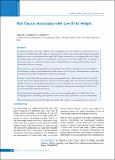Please use this identifier to cite or link to this item:
https://hdl.handle.net/20.500.14356/1984Full metadata record
| DC Field | Value | Language |
|---|---|---|
| dc.contributor.author | Yadav, D K | - |
| dc.contributor.author | Chaudhary, U | - |
| dc.contributor.author | Shrestha, N | - |
| dc.date.accessioned | 2023-06-05T05:39:51Z | - |
| dc.date.available | 2023-06-05T05:39:51Z | - |
| dc.date.issued | 2011 | - |
| dc.identifier.citation | YadavD. K., ChaudharyU., & ShresthaN. (2011). Risk Factors Associated with Low Birth Weight. Journal of Nepal Health Research Council. https://doi.org/10.33314/jnhrc.v0i0.266 | en_US |
| dc.identifier.issn | Print ISSN: 1727-5482; Online ISSN: 1999-6217 | - |
| dc.identifier.uri | http://103.69.126.140:8080/handle/20.500.14356/1984 | - |
| dc.description | Original Article | en_US |
| dc.description.abstract | Abstract Background: Babies with a birth weight of less than 2500 grams, irrespective of the period of their gestation are termed as Low Birth Weight (LBW) babies.1 Despite consistent efforts to improve the quality of maternal and child health, more than twenty million low birth-weight (LBW) babies are born every year throughout the world. Though, the health situation of Nepal has improved substantially over the years, the low birth-weight (LBW) rate still high. The present study was to explore the effects of various maternal risk factors associated with low birth-weight of institutionally delivered newborns. Methods: A cross sectional hospital based study was conducted in Obstetrics and Gynaecology ward of Janakpur Zonal Hospital, Janakpur, Nepal from December 2009 to January 2010. Altogether 306 respondents were taken and respondents were mothers who have delivered newborns in hospital. Results: A total of 1426 birth occurred during the study period (December 2009 to January 2010), of which 306 met the study criteria. Among which 66(21.56%) were low birth weight (LBW) and 240 were normal birth weight (NBW). Overall mean birth weight was found to be 2.75 ± 0.639 kg. Out of total 21.56 % newborns were weighing less than 2.50 kg and mean birth weight was 1.96 ± 0.409 kg.The study also shows that majority 73 (86%) of the research centers didn’t start the research yet. Conclusions: This study suggests that there are several factors interplaying which lead to LBW babies. Socio-demographic factors (maternal age, educational level and economic status) and antenatal care are more important. Keywords: antenatal care, low birth weight, maternal and child health services, maternal risk factors, newborn. | en_US |
| dc.language.iso | en | en_US |
| dc.publisher | Nepal Health Research Council | en_US |
| dc.relation.ispartofseries | October;266 | - |
| dc.subject | Antenatal care | en_US |
| dc.subject | Low birth weight | en_US |
| dc.subject | Maternal and child health services | en_US |
| dc.subject | Maternal risk factors | en_US |
| dc.subject | Newborn | en_US |
| dc.title | Risk Factors Associated with Low Birth Weight | en_US |
| dc.type | Journal Article | en_US |
| local.journal.category | Original Article | - |
| Appears in Collections: | Vol 9 No 2 Issue 19 October 2011 | |
Files in This Item:
| File | Description | Size | Format | |
|---|---|---|---|---|
| 266-Article Text-264-1-10-20130822.pdf | Fulltext Download | 626 kB | Adobe PDF |  View/Open |
Items in DSpace are protected by copyright, with all rights reserved, unless otherwise indicated.
